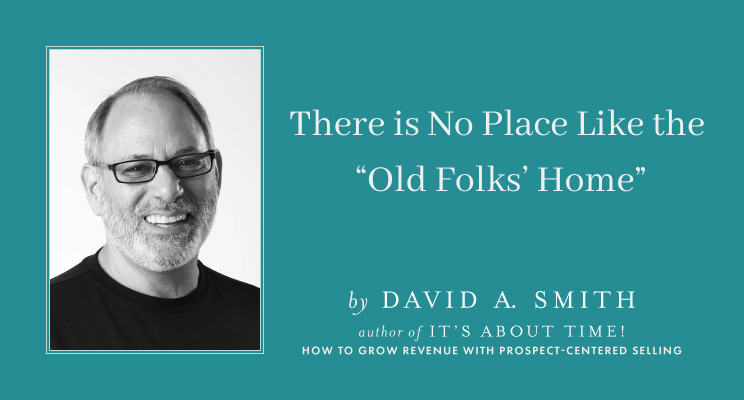Converting Your Senior-Living Prospects is All About Time in the Selling Zone
The following is adapted from It’s About Time!
Anyone who has worked as a senior living sales counselor knows that time is their most valuable and limited resource. That truth became apparent to me early on in my career as a senior housing sales professional, and it wasn’t long before I realized that my success was tied to how I spent my time.
Once I began leading sales teams, I started tracking their focused sales time against their results. That simple relationship became a key to our success: the more time we invested in focused sales efforts, the more successful we became. That truth became the foundation of investing Time in the Selling Zone® (TSZ), a way to quantify the behaviors that lead to sales conversions.
What I’ve found—and there are studies to support this—is that spending more TSZ with prospects and their families allows for more meaningful interactions. This additional time leads to greater trust and more opportunities to help prospects confront resistance, which allows prospects to be more open to hearing your advice.
Let’s take a closer look at how top performers use their TSZ, as a guide to best help your prospects navigate through their emotional resistance to moving. This will result in the win-win of increasing their quality of life and increasing your conversion rates.
How Much Time Does it Take?
One of the most common questions I hear when I talk with new sales counselors about TSZ is, “How many selling hours does it take to convert prospects who do move in?” What we found is that it took about 10 hours in TSZ for assisted living (AL) prospects and about 20 hours for independent living (IL) rental prospects. These numbers were typically higher for communities with higher levels of care.
We have also found that only about half the time spent at work can actually be spent in the Selling Zone. That is because, when done well, connecting and untangling prospect fears is emotionally exhausting work for the counselors. Moreover, even in the most productive sales offices, there are still various tasks, meetings, and non-sales activities that need tending to.
Therefore, the amount of total selling time available is a critical factor driving sales success. Assuming that the typical sales counselor generates 50 percent of their working hours in the Selling Zone for 22 eight-hour days, each counselor has only about 88 hours in the Selling Zone available each month. That’s it. So it is essential that you use those precious hours to our greatest benefit.
Planning and Follow-Up Count
Remember, it isn’t just the amount of time that matters. How you spend that time is equally as important. In law, I spent a great deal of time building case studies for my clients and any relevant subject matter. Time was dedicated to research. My approach was planned carefully after weighing multiple options. I was over prepared in every instance.
In sales, I realized that time invested in planning a conversation or interaction and following up after was not considered to be “selling.” Yet from experience, I found that individualized planning to establish a strategy to advance a specific prospect was just as valuable in terms of closing as time spent in a conversation or interaction. The more well-informed my teams and I were, the more prepared we were to be present in our interactions with prospects, and the better we performed.
In law, once you spend the time on research and planning, you craft a strategy for your approach. Then you identify tactics that execute vital elements of that strategy. How does that apply to sales? We invest time in our prospects. We remain curious, challenging assumptions and exploring motivators and fears to find out all that we can about who this person is and where they are on an individual readiness journey.
As their guides through a major life transition, we craft a strategy to help our prospects untangle the unresolved emotional obstacles on their path. Our strategy may be something like, “Build trust by evoking stories that reveal their life story.” Our tactic may be, “Visit their home to explore a family photo album.”
Activities That Constitute TSZ
From this perspective, we realized we needed to redefine what key activities constituted direct selling time. Senior living operators consider time invested in every area of their business other than sales: housekeeping, nursing, personal care, food services, transportation, etc. They also generally track the calendar days that it takes from inquiry to move-in but, surprisingly, not the factors that might accelerate that time frame.
Most operators think of a sales counselor’s time spent on marketing, advertising, or events as selling time. In addition, they include time spent on activities or tasks that are operational in nature. These are tasks like move-in coordination, new resident orientation, and helping with resident or prospect gatherings. While assisting in marketing or operations is necessary sometimes, those activities do not drive higher sales conversions. It was obvious that we needed a new definition of direct selling time.
We coined “Time in the Selling Zone” to include the time invested in individual prospects for engagements that are face to face (directly with the prospect or their family members); voice to voice (plus all non-face-to-face prospect engagements such as email, text messaging, or mail); time spent planning before or after prospect engagements, including exploring life stories through conversations and internet research, assessing readiness, and thinking about best next steps; and time invested in creating personalized, creative prospect follow-up.
More Time Per Lead Worked
Spending more time with fewer prospects is what most drives higher sales conversions. What we found, doing our own study, was that those communities that spent one hour or less per prospect averaged a 21 percent visit-to-move-in ratio. In contrast, the communities that spent an average of two and a half hours or more with each prospect improved sales results by an astounding 90–100 percent.
It takes time to make emotional connections, build trust, and help prospects get ready. Since time is a limiting factor, how can you increase the time invested per prospect? First, you can delegate non-sales activities. Anything that’s not directly related to selling and getting the prospect across the readiness gap, like move-in coordination or event planning, can easily be done by somebody else at a much lower expense.
While counterintuitive, reducing the number of leads is a second way to get more TSZ. How many leads are enough? In a stabilized community, you don’t need more than 10 to 15 leads for every vacant unit—even with average industry visit-to-move-in conversion rates. If you have more leads than that, and most providers do, processing, qualifying, and working on that many leads reduces the time you have left to spend in the Selling Zone.
Don’t bulk up on leads. It doesn’t help you or your prospects. Regardless of how many active leads you have, top performers can really only focus intensely on about 10 prospects at a time. They try to generate lots of small steps with each, one small step after another. They do this over and over again. The key to a successful sales marathon approach is to “close” on the smallest possible advance in the sale as soon as it becomes possible.
Quality TSZ Increase Your Chances of Success
In our industry, top sellers spend more time working with each lead. They invest nearly 50 percent of that time in planning before each prospect interaction and in doing personalized creative follow-up afterward. They shift the target from a focus on velocity to one of planning and purposeful deliberation. They also create intermediate prospect outcome targets (advances) along the way, from inquiry to close.
If you invest in quality TSZ, your senior living sales results will improve. You can identify, track, set goals, and focus on improving the key sales behaviors that have been proven to increase sales results.
In the end, you win. Your community and company win. But perhaps even more important, a prospect-centered perspective will help enhance the lives of many of the 90 percent of senior adults who fearfully cling to their houses and to lifestyles that no longer fit their needs. In my opinion, that’s the biggest win of all.
For more advice on how to make your time in the selling zone as effective as possible, you can find It’s About Time! on Amazon.

